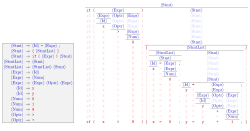
Back قواعد خالية من السياق Arabic প্রসঙ্গমুক্ত ব্যাকরণ Bengali/Bangla Gramàtica lliure de context Catalan Bezkontextová gramatika Czech Kontextfreie Grammatik German Gramática libre de contexto Spanish دستور بافتآزاد Persian Yhteydetön kielioppi Finnish Grammaire non contextuelle French Gramática libre de contexto Galician
This article needs additional citations for verification. (February 2012) |

In formal language theory, a context-free grammar (CFG) is a formal grammar whose production rules can be applied to a nonterminal symbol regardless of its context. In particular, in a context-free grammar, each production rule is of the form
with a single nonterminal symbol, and a string of terminals and/or nonterminals ( can be empty). Regardless of which symbols surround it, the single nonterminal on the left hand side can always be replaced by on the right hand side. This distinguishes it from a context-sensitive grammar, which can have production rules in the form with a nonterminal symbol and , , and strings of terminal and/or nonterminal symbols.
A formal grammar is essentially a set of production rules that describe all possible strings in a given formal language. Production rules are simple replacements. For example, the first rule in the picture,
replaces with . There can be multiple replacement rules for a given nonterminal symbol. The language generated by a grammar is the set of all strings of terminal symbols that can be derived, by repeated rule applications, from some particular nonterminal symbol ("start symbol"). Nonterminal symbols are used during the derivation process, but do not appear in its final result string.
Languages generated by context-free grammars are known as context-free languages (CFL). Different context-free grammars can generate the same context-free language. It is important to distinguish the properties of the language (intrinsic properties) from the properties of a particular grammar (extrinsic properties). The language equality question (do two given context-free grammars generate the same language?) is undecidable.
Context-free grammars arise in linguistics where they are used to describe the structure of sentences and words in a natural language, and they were invented by the linguist Noam Chomsky for this purpose. By contrast, in computer science, as the use of recursively-defined concepts increased, they were used more and more. In an early application, grammars are used to describe the structure of programming languages. In a newer application, they are used in an essential part of the Extensible Markup Language (XML) called the document type definition.[2]
In linguistics, some authors use the term phrase structure grammar to refer to context-free grammars, whereby phrase-structure grammars are distinct from dependency grammars. In computer science, a popular notation for context-free grammars is Backus–Naur form, or BNF.
- ^ Brian W. Kernighan and Dennis M. Ritchie (Apr 1988). The C Programming Language. Prentice Hall Software Series (2nd ed.). Englewood Cliffs/NJ: Prentice Hall. ISBN 0131103628. Here: App.A
- ^ Introduction to Automata Theory, Languages, and Computation, John E. Hopcroft, Rajeev Motwani, Jeffrey D. Ullman, Addison Wesley, 2001, p.191
© MMXXIII Rich X Search. We shall prevail. All rights reserved. Rich X Search








